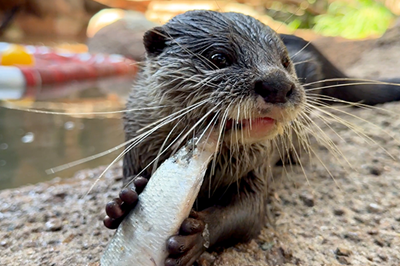These two live in the Asian Rainforest and are full of energy, curiosity and charm. If you’ve ever walked past their habitat, you’ve probably heard their high-pitched chatter or seen them zipping through the water.
Let’s dive into some fascinating facts about Asian Small-clawed Otters!
Small but mighty
Asian Small-clawed Otters are the smallest otter species in the world, but don’t let their size fool you—they’ve got big personalities and even bigger appetites!
Weighing in at around 4.5 kg and stretching up to 60 cm, these little carnivores love to snack on fish, molluscs, crustaceans, and worms. At the Zoo, Sati and Squid each enjoy about 1kg of food a day, served up in creative ways to help keep them busy and engaged.
And here’s a quirky habit, they often wash their food before eating it!
Enrichment is everything
Enrichment is a huge part of daily life. Keepers hide food by scattering treats around their habitat. This keeps the otters mentally sharp and encourages natural behaviours like foraging.
Fun fact! In the wild the male will hunt for the female and her pups as they develop.

Otter talk and territory
Otters are master communicators. Sati and Squid have a whole range of vocalisations – at least 12 different calls which are used to greet each other, warn of danger, or just say “hello.” Some of their chirps are so high-pitched that visitors often mistake them for birds!
They also use scent glands to mark their territory. Their scent marked faeces called “spraint” is a territorial way of saying “This spot is taken!” Wild Asian small-clawed otters smear their spraint around their home.
Family life
Asian Small-clawed Otters are monogamous, often pairing for life and raising their pups together. In the wild, the male even helps feed the female and pups while they grow.
Otter pups start learning to swim at just a few weeks old, with a little encouragement (push!) from mum or dad.
Harsh reality for otters and how you can help
All 13 otter species are threatened by the destruction of their aquatic habitats through pollution, urban development and the agriculture industry. Habitat loss, especially from unsustainable palm oil production, is putting pressure on their populations.
How you can help:
- Download the PalmOil Scan app to check if products use sustainable palm oil.
- Choose certified options or go palm oil-free when you can.
Remember, every small action helps protect otters and their rainforest homes.
Catch them in action
Come visit Sati and Squid at Perth Zoo and see their playful antics for yourself. You can catch a FREE (with your Zoo entry) otter talk and feed daily at 12:15pm. You’ll meet the keepers who know them best and watch as these aquatic hunters feast on enrichment.
More otterly awesome fast facts
🐟 Otters wash their food before eating.
💅🏼They have fingernails instead of claws.
🐾 Their paws are super dexterous–perfect for prying open shellfish.
🦦 They reach adult size in about 6 months. Lifespan in the wild is 11-16 years.
🍴 They eat 6–7 small meals a day.
🌍 They’re a keystone species, playing a vital role in their ecosystem.
Join Keeper Lisa on her morning round with our playful, curious and energetic pair. Check out the video below 